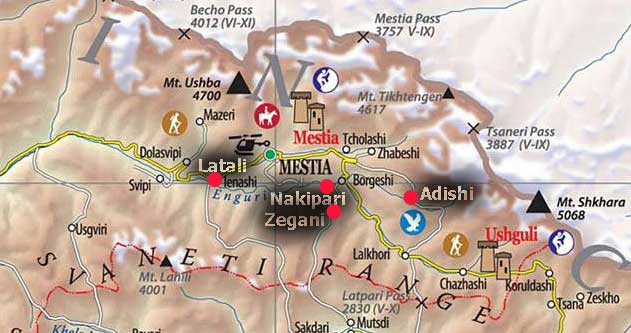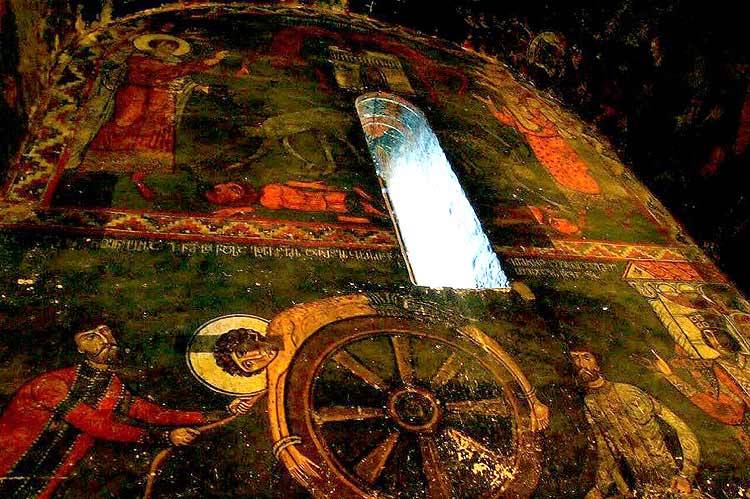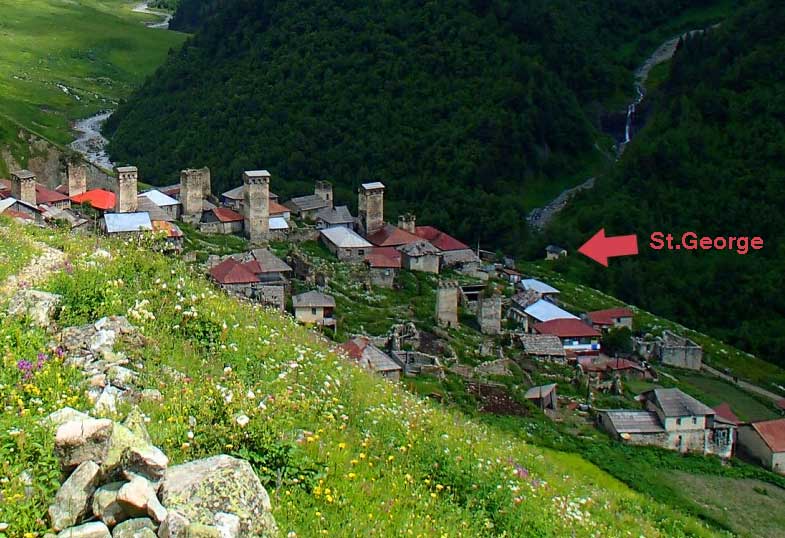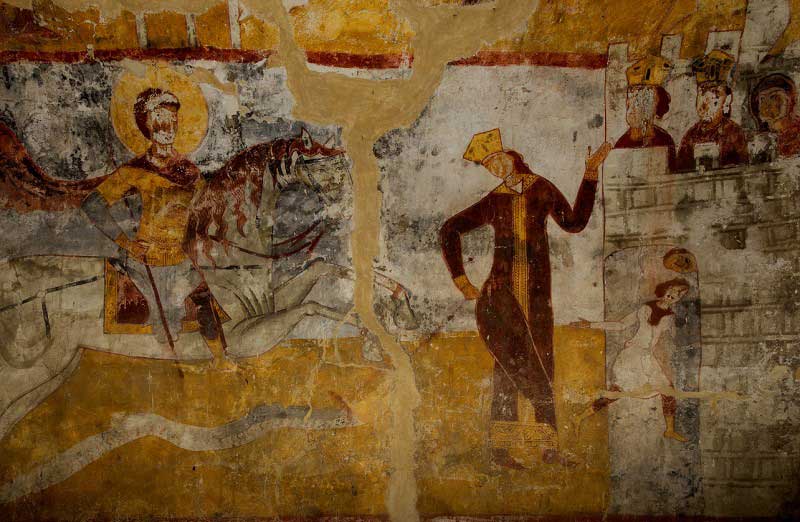|
Short sketches about some of the most interesting villages in Svaneti. Nakipari So close to the main road (Mestia-Ushguli) and somehow not given enough attention! Descending from the Ugviri Pass (that connects Mulkhura and Inguri valleys) and looking south you will notice a few villages. In the background is a snow covered Mt.Lasili (3495m). These villages belong to Ipari (do not confuse with IpRari) community and unless you go to Ushguli for a day trip it make sense to explore them. Also, you can do it if you walk from Hatsvali via Tsvirmi. In Bogreshi village (on the main road below Ugviri pass) cross the bridge and walk for 10 minutes to Nakipari. Entering Nakipari you will notice (on your left) a group of birch trees and a simple stone structure. This is a church of St.George (Dzhgrag) where you will find some precious icons and unique frescoes painted in the year 1130. Eastern façade of the church has animal relief similar to the ancient art of south Russia and Northern Caucasus. It shows that pre-christian beliefs haven't disappeared altogether and were incorporated into newly introduced religion. Inscription of a date and artist's name (Tevdore) is not visible anymore. But in 1938 professor Amiranashvili could still detect it. Frescoes give an impression of grandeur despite small size (25 sq.m.) of the church and they are relatively well preserved. Tevdore was a local artist who also decorated walls of the churches in Iprari, Tsvirmi and Lagurka. Faces with typical Svan features look familiar, passing through villages you might see them ... Nowhere in Georgia you will find anything similar to this style of powerful yet naive character. below: Martyrdom of St.George on the western wall Adishi It is always surprising how many people are completely ignorant about cultural treasures found in many villages of Svaneti. Everybody visit Mtsheta and Gelati to admire their art treasures. Svaneti is considered for hiking only and hardly anyone know that the most ancient examples of Georgian fresco art can be found here. So let's talk about Adishi. This village has many abandoned houses and it's atmosphere is rather melancholy. After snow year of 1987-1988 (even in summer valleys were packed with snow) many people left for Tbilisi. Adishi is a "dead end" village so there are no passes here that lead to the North Caucasus. And it is actually higher than Ushguli... There are three churches in Adishi and the smallest one is dedicated to Dzhgrag (St. George). It is tiny, has frescoes on the exterior walls and flamboyant, colorful frescoes inside showing scenes from the life of St. George. The style is naive but in this rather grim village it makes for good. Frescoes are not signed but belong probably to 14th century. Like other churches in Svaneti it is in poor state of preservation. Another church is Matshvari (Savior) is larger and is known for so called Adishi Gospel that was found here covered with thick layer of dust. Imagine now, that this first illustrated Gospel in georgian language was kept here for centuries (and it was made in 897, era of Carolingian dynasty in Europe) just below glaciers of Tetnuldi in the most distant corner of Georgia! Today this unique book can be seen in the Svaneti Museum of History and Ethnography (Mestia). Zegani Another small but beautiful village that hardly anyone visits. Zegani belongs to Ipari community (just as neighboring Nakipari) and it takes only 20-30 minutes walk to get there from the Mestia-Ushguli road. The village is on the slightly inclined plateau above the confluence of Inguri and Lasil. Dark waters of Lasil run from the Svaneti Range that is composed of brittle black shale, hence the color. There are only 13 families living today in Zegani. Many young people leave for Tbilisi and it is inevitable. Village life is hard and monotonous. There is only one guesthouse (without any sign, just ask around) in Zegani and it belongs to Djaba Khvistani. below: View to the south. Old tower of Zegani and Lasil Valley below: Village lichme labours. Latali Traveling from Zugdidi to Mestia you pass through Latali, the "border community" of Free Svaneti. Further down, all the villages were ruled by House of Dadeshkeliani and as a result most towers there were destroyed. Above Latali Svaneti was independent. There are only 9 km from Latali to Mestia but they are worlds apart. Latali is not yet touched by tourism and retains it's rugged character. Svaneti Range with snow dome of Ladura (3758m) and wide shoulders of Layla (4008m) rises high above the village. There are number of interesting, ancient churches in the villages of Latali . Matskhvari (Savior) church stands on the hill over the main road and by far the most impressive. Frescoes painted by Mikael from Maglaki in 1142 are in relatevely good condition. Prevalent color scheme is blue-grey with brown-red and this restrained palette is incredibly powerful. Manner is rather stiff and bear a strong resemblance to capadocian style. below: Jonah Church in Yenashi village (Latali) On Saturdays, Sundays and holidays the churches are open in the morning and late afternoon. If you visit on other days it is complicated. Ask locals and you might be lucky!
20 Comments
|












 RSS Feed
RSS Feed